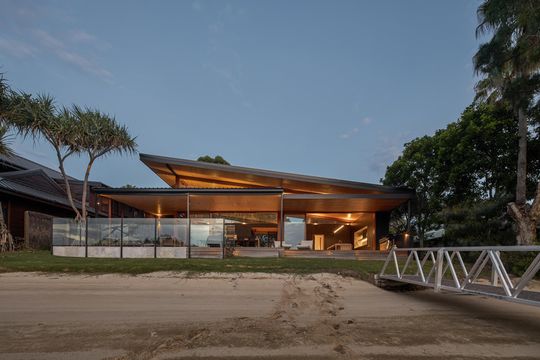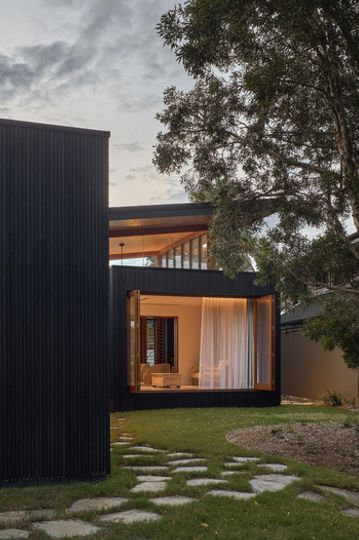Today for Lunch with an Architect, we have the pleasure of chatting with Darren Greenaway, a director at BDA Architecture based on the Gold Coast. Darren recently designed his own home, The Island House, on South Stradbroke Island, off the coast of the Gold Coast. We chat about the unique challenge of designing a home for yourself, designing for climate and site, helping clients visualise their space, and Midnight Oil!
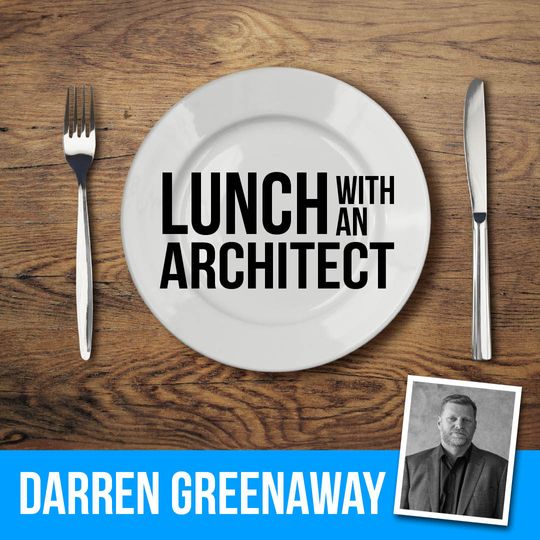
Thanks for joining me today, Darren. It’s lovely to meet you, even if it’s only virtually. Since this is a virtual lunch, I’m curious—if we were heading out for lunch together, where would be your favourite spot?
One of my favourite places is Glenelg steakhouse here on the Gold Coast. It’s a great local business with good food and wine, so that’s where we’d be heading.
That sounds like a great choice. Now, can you tell me what drew you to architecture? What inspired you to become an architect?
I’ve always enjoyed sketching, especially when I was younger. I used to draw cars and floor plans of houses. My dad also loved drawing floor plans, and he even built one of our early houses. I think that early exposure to how buildings come together really sparked my interest. So, I always loved sketching floor plans and thinking about space in a house. And during my travels I was inspired by a lot of different vernacular architecture and the way buildings are designed in different cultures. There has always been an interest there, I think.
Just steps from the beach, Island House is designed to take advantage of its stunning natural location.
That’s interesting. You mentioned travel. Did those experiences influence your approach to architecture?
Definitely. After university, I did a lot of reading and reviewing different buildings around the world. But it wasn’t until I started travelling in my twenties that I truly opened my eyes to architecture. Seeing how different cultures influence building design really reinforced my decision to become an architect. For example, I travelled to places in Southeast Asia like Thailand and cities like Bangkok, as well as to London and various parts of France. It was fascinating to see how people adapt their architecture to suit the climate and available materials.
It must have been incredible to see those different approaches firsthand. Speaking of adapting to the environment, I noticed that your project on South Stradbroke Island really takes into account its surroundings. Can you tell me more about what inspired that project and how you dealt with the local climate and environment?
South Stradbroke Island is a beautiful, quiet place, much of it untouched and preserved as a natural reserve. I wanted to create a holiday house that really engaged with the existing landscape. The idea was to make the house as open as possible, not just to the waterfront but also to the streetscape, which is lined with paperback trees and palms. We wanted to bring that landscape into the courtyard of the building so that from the living spaces, you can see through to the outside and feel connected to the environment. The house is very open and transparent, with no curtains in the living areas, so anyone passing by can look through, which I think adds to the sense of community.
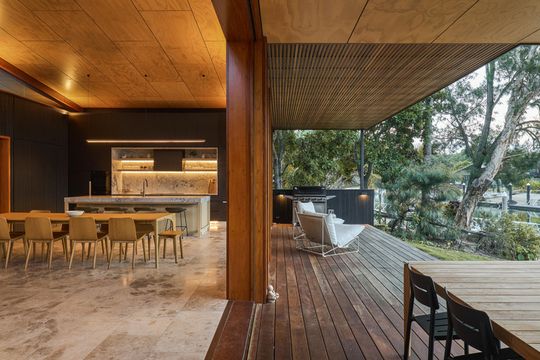
With a seamless indoor/outdoor connection, Island House encourages Darren and family to spend more time outside and enjoy the natural environment.
That sounds like a wonderful approach. How often do you get to go and enjoy the house?
Not as often as I’d like, unfortunately. The plan was to go a couple of weekends a month, but life gets busy with kids, work, and sports. We try to get there whenever we can because it’s so relaxing and beautiful, like a hidden gem on the Gold Coast.
I can imagine! I’m a bit envious—it sounds like a stunning spot. Shifting gears a bit, do you have a “superpower” when it comes to architecture?
I wouldn’t call it a superpower, but I think we’re very good at analysing a site and breaking it down into simple components. We can put together a thought-out design that’s responsive to the site, the climate, and the client’s brief. I’m pretty good at forming conceptual ideas quickly through a process of investigation and collaboration with the client and consultants.
That’s a great strength to have. How much research and effort do you put in before you start designing? Is it something that comes intuitively, or do you need to build up a collection of information first?
It depends on the site, but for something on the Gold Coast, we always start with thorough research. We look at where the site sits, the climate, the sun’s path, wind directions, and any privacy issues. We also do topography analysis. This process helps us understand the site before we start the design. Visiting the site is crucial too because you get to see things that maps and data can’t show you, like breezes and view lines.
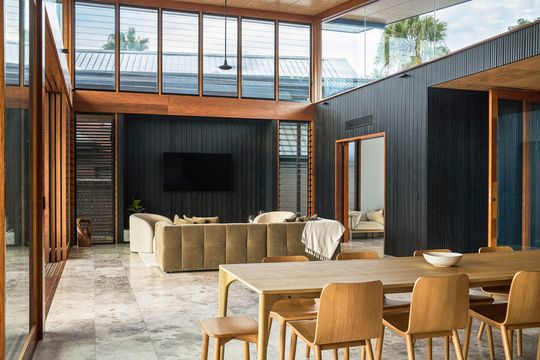
Clerestory windows make Island House feel very light and bright and allows it to be naturally ventilated.
That makes a lot of sense. What’s your favourite thing about residential architecture?
I love how personal it is. Each design is unique and client-responsive. It’s about more than just our design ideas—it’s about collaborating with the client to create something that reflects their needs and desires. The emotional connection you build through this process is incredibly rewarding. You also have the freedom to use materials and space planning in ways that can significantly impact how people feel in their homes.
Absolutely. It must be a special privilege to work on something as personal as someone’s home. What’s the first album you ever bought?
Funny enough, the first album I ever bought was by Midnight Oil. It was the Diesel and Dust album and my favourite song was Beds are Burning. It was on cassette, actually. I also remember buying a Billy Idol album and later, Pearl Jam. Those were some of my first music purchases.
Have a listen to some of these classics!
Nice! Is there a particular challenge in residential architecture that you enjoy?
The biggest challenge is trying to understand what a client likes. They have a lot of good ideas but it’s about trying to break it down into simple components to allow a clear strategy moving forward. Not everyone can visualise a floor plan, so the challenge is how to communicate that effectively.
How do you help clients who struggle to understand the plans?
We use hand sketches to help clients understand how the spaces will work together and try to take them to similar spaces, either in our office or in another building, so they can feel the space and see how light and size work. This helps them to visualise the project better.
It sounds like you have a thoughtful approach to guiding clients through the process. Is there a residential project you’re particularly proud of?
Honestly, I’m proud of all the projects I’ve worked on. Each one is unique and designed specifically for the client. I don’t like following trends; I prefer to try something different each time, which makes every project special to me.

BDA Architecture are one of the largest architecture firms on the Gold Coast and they work on numerous projects of various scales.
What was it like working on your own project?
It was challenging. You’re a lot more critical of yourself when it’s your own project. For our family’s holiday house, I wanted it to be open and transparent, a place where we could hang out with friends and family. The planning ended up being simpler once I focused on the basics, like climate and views, rather than trying to do something just for the sake of being different.
A courtyard entry allows the living area of Island House to open up to the outdoors on both sides.
That sounds like a thoughtful process. If you could have an ultimate dinner party, who are the four people, from any time period, you’d invite and why?
That’s a tough one! I’d probably choose architects like Le Corbusier, Mies van der Rohe, and Gaudi. It would be fascinating to understand their thought processes, how they were trained, and what inspired them. These are people we’ve all read about, but it would be amazing to hear their stories firsthand.
That would be a fascinating group! Speaking of architects, who do you prefer—Le Corbusier or Frank Lloyd Wright?
That’s hard to choose! They both have different styles, but Le Corbusier was ahead of his time with his big-picture ideas, not just in houses but in urban planning. I admire his vision for how buildings interact with the landscape. Frank Lloyd Wright’s work is also incredible, especially his ability to break down the composition of a building. But I’d have to lean towards Le Corbusier for his forward-thinking approach.
That’s a solid choice. Is there a piece of advice you’d give to someone looking to build or renovate their home?
I’d advise living in the place for at least six to twelve months before making any major changes. This helps you understand how the home works across different seasons—where the sun comes in, how cold it gets in winter, how you use the spaces, and so on. It’s a great way to refine your brief and make sure the changes you want to make are really what you need.
That’s excellent advice. Lastly, is there something about architecture that you wish more of the general public knew?
I wish people knew that architects aren’t just about big egos and over-designing things. We’re really here to help bring people’s visions to reality and to contribute to building great cities and communities. It would be nice to change the perception that architects are unapproachable or that it’s our way or the highway. We’re really about collaboration and helping people create spaces they’ll love.
